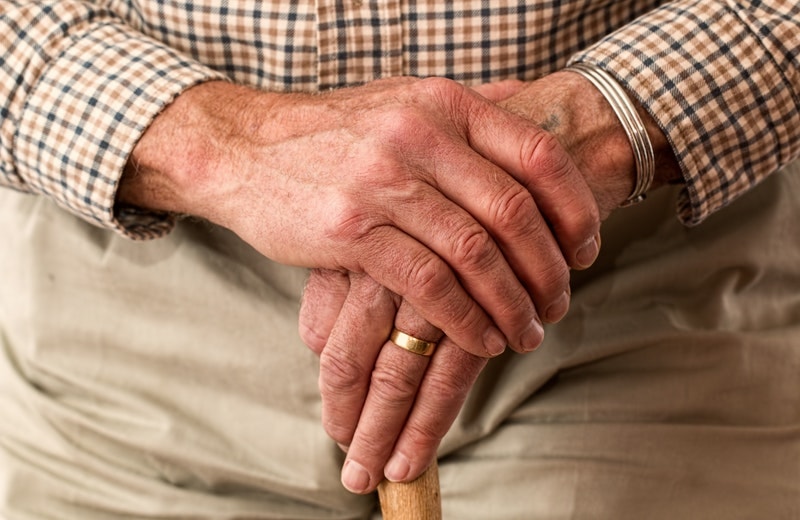Shingles, also known as herpes zoster, closely resembles chickenpox. This virus occurs when the dormant chickenpox virus reactivates in your nerve tissues. Because many of the virus’ symptoms are visual, you may be able to decide whether or not you have it without first visiting your doctor. Often manifestations of herpes zoster will appear first around your rib cage or waist, resembling a belt. It then appears as fluid-filled sores that eventually scab over and heal about two to four weeks after they make their appearance. Earlier signs of shingles are tingling, extreme tiredness, shooting pains, and redness of the skin.
1. Blisters
One to three days after pain begins, blisters will typically appear on the inflamed, red skin. For a few days, new ones will continue to show up. Not all people develop these sores, but most do. It will look like a rash with groups of raised, red bumps erupting in the same places where the pain has been felt. Although most of these red bumps appear on the face and torso, sometimes they appear on the lower body or spine. It is uncommon for them to appear over your entire body. During this time, it is recommended to wear loose-fitting clothing in order to keep the blistered skin from becoming more irritated. Eventually, the sores crust over.

2. Scabs
After 10-12 days, the sores, or ulcers, will typically erupt and ooze fluid, or turn a yellow color and flatten. They then dry out, begin to scab, and crust over in one to two weeks. Around this time, your pain may begin to ease; but some people have reported months, or even years, of recovery and pain-lessening.
Fortunately, those around you are very unlikely to contract this virus once your blisters have completely crusted over.
3. Ulcer of the Skin
Open sores, or ulcers, often follow the redness and blistering. These open sores are filled with fluid and pus, resembling chickenpox. Unfortunately, these ulcers may become infected and bacteria can multiply. Any open sores are always susceptible to bacterial infection.
Itching commonly accompanies these ulcers of the skin. Beware of scratching, which can make scarring more likely to result. The ulcer of the skin will eventually crust over, and the rash will disappear. You may experience changes in your skin color along with the scarring. By this time, you are no longer contagious.
4. Redness of Skin
Most likely, the first visual symptom to indicate you have this virus will be redness of the skin. You will see pink or red blotchy patches, usually on one side of your body, or around your torso. The redness typically shows up in patches clustering along the nerve pathways. This is the precursor to the rash that develops and wraps around the left or right side of your torso.
In some cases, the redness and rash can appear on your face, on one side of your neck, or even around your eye.
5. Burning Sensation
Sometimes, even before the redness on your skin appears, you may feel a burning sensation in certain areas of your body. Other symptoms that usually accompany the burning are tiredness, a fever, weakness, or a tingling sensation. These are all early manifestations of the virus that occur a few days before the first signs of a rash appear on your skin. Instead of a burning sensation, some people say that they feel shooting pains in the areas that the rash later appears on.
6. Fatigue
Fatigue is another early shingles symptom that can develop early and continue for a few days or weeks. This is a feeling of extreme tiredness or exhaustion. You may feel inadequate to accomplish simple, daily tasks. Fatigue is your body’s response to the extra physical burden of your body’s immune system fighting and working hard. Take plenty of time to rest and lie down. Understand that you may need to take extra breaks during your work or chores. Resting will allow your body to fight well and heal more quickly! You may even want to take a relaxing oatmeal bath. Not only will it give you the opportunity to rest, but it will also help in easing any pain or itchiness that you are experiencing.
7. Itching
Besides the early symptoms of skin redness and burning, itching is also common. It can start even before the rash has shown up on your body. Usually, where you are feeling itchy is where the ugly rash will appear in a few days or weeks. Sometimes, this need to itch is constant; or it may come and go. Some people describe this feeling as a tingling sensation, or a feeling that their skin is prickling and oversensitive. It is almost like a pins and needles sensation. This symptom can be lessened by applying a cold, wet compress to the rash. You may also want to apply calamine lotion to the itchy areas. This painful and irritating virus can strain you physically and emotionally.
Make sure to get sufficient rest, ask for help from your friends and family, and find easy activities to do that will distract you from the pain and itchy skin. It is important to not associate with those who have not yet had chickenpox or the chickenpox vaccine. They are likely to contract the virus if they come in direct contact with your rash. Lower your risk of infected open sores by keeping your skin clean and avoiding scratching. If you notice signs of infection, notify your doctor immediately. Your doctor will ensure that you receive treatment to prevent the infection from spreading. Be encouraged that most people see the rash disappear within two to four weeks!